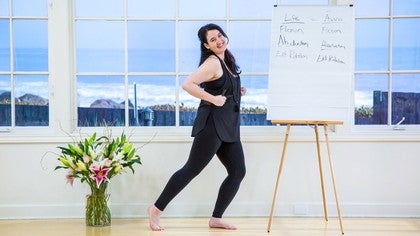Description
Transcript
Read Full Transcript
you can think of your thigh as being separated into four quadrants you have a front you have a back you have an outside and an inside and more or less the front quadrant of your thighs made up mostly of your quadriceps do for a living hip flexion the ones in the back quadrant of the thigh for the most part do extension at the hip the outside does a beduction or abduction the inside does a deduction now we will go over some of those muscles later but I want to look at we tend to have a favorite way of moving both in life and in Asana so let's say in Asana well let's say in life first in the last 10 days of your life did you do more hip flexion so walking to work sitting in your car eating typing computer right driving back home sitting watching Netflix and then going to sleep right or did you do more extension at the hips I don't know your life but I'm gonna guess you did more flexion at the hips so last ten days did you do more a beduction at your hips or a deduction at your hips this one's slightly more debatable because as a woman I tend to cross my legs politely but sometimes even when I'm by myself I just fall into that habit of crossing my legs but for the most part if no one else was around we tend to default into abduction rather than adduction and even when we walk unless you're a supermodel even when we walk we kind of kick our legs out to the side a little bit a little bit more abduction in our life so I'm gonna it's a close call but I'm gonna make the case a be deduction at the hips last ten days of your life did you do more external rotation at the hips or internal rotation at the hips I'm gonna say that's a pretty easy one most people would say external rotation so we have this kind of clear asymmetry that starts to form not just in the habitual movements but it's the muscles the sinews the tissues of the body that are forming these habits and so certain muscles will get hyper contracted certain muscles underutilized maybe weak certain muscles kind of stuck together kind of like if I were to ask you how do you feel about your inner thighs are they stir-rong and ready to go and you can feel great connection to them or are they kind of like hanging out unless you are doing a lot of that Suzanne summer thigh master action most of us might say well they feel a little bit disconnected or if I asked you how do you feel about your outer compartment do you feel like it's supple like butter or do you feel like it's a slab of concrete you think most of us might confess that it feels a little bit like concrete then we get to an asana practice so think of the last ten practices that you did especially in the group practice did you do more hip flexion with ten asana downward-facing dog Pashima ten asana about a canassana fold forward pigeon fold forward or did you do more hip extension bridge pose shalabhasana camel pose chances are I get the opportunity to travel to many different studios and what I see most often is that we favor flexion we favor those poses that are creasing at our hips last ten practices did you do more abduction of your hips or adduction I'm going to say there's actually not a lot of poses that involve true a deduction of our hips I can think of Eagle or maybe cow face pose the cow legs go mukasana maybe taking the leg across the body in a twist but other than that we do a lot of taking the legs away from one another think warrior to our attention dress and all these kind of open hip postures so I'm gonna say a beduction last ten practices did you do more external rotation of the hips or internal rotation of the hips there's there's no no battle here we did more external rotation again not a lot of postures are asking for true internal rotation now if you look at the same imbalance that we're kind of gathering in life is then being reinforced in our asana practice that leads to just strengthening the imbalance now we learn more by going against our habits we learn more by going against kind of our favoritism I think teachers are doing a great job in offering blocks between the thighs or coming up with postures that are crisscross or a little bit more creative to try to bring in more extension of the hips strengthening of the hamstrings adduction strengthening of the inner thighs and internal rotation a better balance in the hip socket bringing a better balance not just helps the hips but everything above and everything below because everything is connected
Your Body on Yoga: Lower Appendage
Comments
You need to be a subscriber to post a comment.
Please Log In or Create an Account to start your free trial.
















